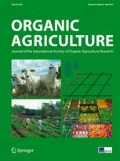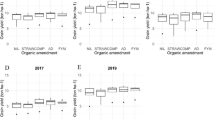Abstract
A study was conducted to compare organic and conventional rice production within and between three agro-ecological zones (AEZ) under farmers’ management in Bhutan. Soil properties, rice grain yield and benefit-cost return (BCR) were compared between two production systems in 2012 and 2013. Total nitrogen (N) was significantly higher in the organic farm in 2013. Soil organic matter (OM) and available phosphorus (P) were the only soil parameters that were consistently and significantly higher in the organic farm in both years. In the mid AEZ, available P was significantly higher in the organic farm in both years. In the low AEZ, the total N was significantly higher in conventional farm in 2013. In all three AEZs, there was no statistically significant difference in grain yields between organic and conventional rice farms. However, the grain yield was highest in high AEZ and lowest in low AEZ for both the systems.The costs of plant protection inputs were significantly higher in conventional farm, and cost of manure application and weeding was significantly higher in organic farm. The gross returns from a hectare land did not differ significantly between organic and conventional farms but the production cost from a hectare land was significantly higher in organic farm. The BCR was significantly higher in conventional farm. It is interesting to note that the overall yields did not differ between two systems; thus, at the present selling price of Nu. 60 per kg for both organic and conventional rice, the gross returns are same for both the systems. The study suggests that, with the present management conditions and without considering premium price of organic rice, the conventional rice production is more profitable than organic system in Bhutan. However, if organic rice fetches premium price, then the BCR of organic system may become similar to or higher than conventional system.




Similar content being viewed by others
References
Adegunloye DV, Adetuyi FC, Akinyosoye FA et al (2007) Microbial analysis of compost using cowdung as booster. Pak J Nutr 6:506–510
Altieri MA (1999) The ecological role of biodiversity in agroecosystems. Agric Ecosyst Environ 74:19–31
Birkhofer K, Bezemer TM, Bloem J et al (2008) Long-term organic farming fosters below and aboveground biota: implications for soil quality, biological control and productivity. Soil Biol Biochem 40:2297–2308
Boggs LC, Kennedy AC, Reganold JP (2000) Organic and biodynamic management effects on soil biology. Am J Soil Sci Soc 64:1651–1659
Bouldin RD, Klausner DS, Reid SW (1984) Use of nitrogen from manure. American Society of Agronomy, Wisconsin, USA
Charyulu KD, Biswas S (2010) Economics and efficiency of organic farming vis-à-vis conventional farming in India. Research and Publications Ahmedabad, India, pp 1–26
Chhogyel N, Legjay, Dema T (2013) Grain yield as affected by time of transplanting in mechanized rice farming in Wangdue-Punakha valley. Bhu J RNR 9:15–19
Cook RJ (1988) Biological control and holistic plant-health care in agriculture. Am J Altern Agric 3:51–62
Dong W, Zhang X, Wang H et al (2012) Effect of different fertilizer application on the soil fertility of paddy soils in red soil region of Southern China. PLoS One 7:1–10
Dorji P (1999) Deciduous fruit production in Bhutan. FAO, Banglamphu
Duba S, Ghimiray M, Gurung TR (2008) Promoting organic farming in Bhutan: a review of policy, implementation and constraints. Council for RNR Research of Bhutan, Ministry of Agriculture, Thimphu, Bhutan
Dukpa W, Pem D, Lham G (2007) Growing rice in Bumthang: a dream realized by the farmers. Bhu J RNR 3:102–118
FAO-AGL (2000) ProSoil—problem soils database, land and plant nutrition management service, available from URL: http://www.fao.org/ag/agl/agll/prosoil/calc.htm [Cited 10 December 2014]
FAO-UNESCO (1974) Soil map of the world. Volume 1 legend. UNESCO, Paris
Foth DH, Ellis GB (1997) Soil fertility and plant nutrition. Lewis, Washington, DC
Ghimiray M, Wangdi K, Chhetri BG et al (2007) Rice commodity chain analysis. FAO-FNPP, Thimphu, p 49
Ghini R, Hamada E, Bettiol W (2008) Climate change and plant diseases. Sci Agric 65:98–107
Hoitink HAJ, Inbar Y, Boehm MJ (1991) Status of compost-amended potting mixes naturally suppressive to soil borne diseases of floricultural crops. Plant Dis 75:869–873
Jahanban L, Davari M (2013) Prospects and problems of organic farming and its environmental impacts. 1st International Conference on Environmental Crisis and its Solutions Kish-island, Iran. pp. 549–554
Jenkins HJL, Godwin JR, et al (2010) A comparison between conventional and organic farming practice. 19th World Congress of Soil Sciences, Soil Solutions for a Changing World. Brisbane, Australia, pp
Karma, Ghimiray M (2006) Rainfed lowland rice cultivation in Bhutan: a survey report. Bhu J RNR 2:93–114
Lawanprasert A, Kunket K, Arayarangsarit L et al (2007) Comparison between conventional and organic paddy fields in irrigated rice ecosystem. 4th INWEPF Steering Meeting and Symposium. Rice Department, Ministry of Agriculture and Cooperatives, Pathumthani Rice Research Center, Thailand, pp 1–9
Lee H, Fowler S (2002) A critique of methodologies for the comparison of organic and conventional farming systems. UK Organic Research 2002 Conference. University of Wales Aberystwyth, Organic Centre Wales, pp. 281-284
Luo Y, Teng P, Fabellar N et al (1998) The effects of global temperature change on rice leaf blast epidemics: a simulation study in three agroecological zones. Agric Ecosyst Environ 68:187–196
Maeder P, Fliessbach A, Dubois D et al (2002) Soil fertility and biodiversity in organic farming. Science 296:1694–1697
Mahler LR, Tindall AT (1994) Soil sampling. C. E. S University of Idaho, Moscow
Marinari S, Mancinelli R, Campiglia E et al (2006) Chemical and biological indicators of soil quality in organic and conventional farming systems in Central Italy. Ecol Indic 6:701–711
Mendoza TC (2004) Evaluating the benefits of organic farming in rice agroecosystems in the Philippines. J Sustain Agric 24:93–115
Mendoza TC, Pecadizo ML, Santos WLDL (2001) Comparative case study of organic LEISA and conventional rice farming systems in Quezon Province, Philippines. Philipp J Crop Sci 26:35–40
MoAF (2013) Bhutan RNR Statistics 2012. Royal Government of Bhutan, Ministry of Agriculture and Forests (MOAF), Thimphu
Neuhoff D, Tashi S, Rahmann G et al (2014) Organic agriculture in Bhutan: potential and challenges. Org Agric 4:209–221
Nguyen VN (2013) Factors affecting wetland rice production and the classification of wetlands for agricultural production. Crop and Grassland Service (AGPC), FAO, Rome
Norbu C, Floyd C (2001) Changing soil fertility management in Bhutan: effects on practices. National Soil Service Center, Ministry of Agriculture, Semtokha
NSSC (2009) A guide to fertilizer recommendation for major crops. National Soil Service Centre, Semtokha
Oehl F, Oberson A, Tagmann HU et al (2002) Phosphorus budget and phosphorus availability in soils under organic and conventional farming. Nutr Cycl Agroecosyst 62:25–35
Okazaki M (1987) Soil of the Bhutan Himalaya. Laboratory of ecology. Chiba University, Japan
Pathak H, Kushwala JS, Jain MC (1992) Eyahiation of manurial value of Biogas spent slurry composted with dry mango leaves, wheat straw and rock phosphate on wheat crop. J Indian Soc Soil Sci 40:753–757
Pattanapant A, Shivakoti PG (2009) Opportunities and constraints of organic agriculture in Chiang Mai Province, Thailand. Asian Pac Dev J 16:115–147
Pimentel D (1993) Economics and energetics of organic and conventional farming. J Agric Environ Ethic 6:53–61
Pimentel D, Berardi G, Fast S (1983) Energy efficiency of farming systems: organic and conventional agriculture. Agric Ecosyst Environ 9:359–372
Pimentel D, Hepperly P, Hanson J et al (2005) Environmental, energetic, and economic comparisons of organic and conventional farming systems. Bioscience 55:573–582
Pradhan N (2011) Rice production economics. Bhur, Sarpang, Bhutan
Pulami T (2010) Economics and production trend of organic rice in Damji, Gasa Dzongkhag. Lobesa, Wangdue
Quyenb NV, Sharma SN (2003) Relative effect of organic and conventional farming on growth, yield and grain quality of scented rice and soil fertility. Arch Agron Soil Sci 49:623–629
Rahman S, Parkinson RJ (2007) Productivity and soil fertility relationships in rice production systems, Bangladesh. Agric Syst 92:318–333
Rasul G, Thapa GB (2004) Sustainability of ecological and conventional agricultural systems in Bangladesh: an assessment based on environmental, economic and social perspectives. Agric Syst 79:327–351
Roder W (1982) Experimental works by rural development project, Bumthang. Bhu J Anim Hus 5:55–62
Roder W, Dorji K, Gratzer G (2003) Nutrient flow from the forest—source of life for traditional Bhutanese agriculture. Austrian J For Sci 1:65–72
Rubinos R, Jalipa TA, Bayacag P (2007) Comparative economic study of organic and conventional rice farming in Magsaysay, Davao Del Sur. 10th National Convention on Statistics. University of Southeastern Philippines, Manila, Philippines
Samui PR (1999) A note on the weather and rice yield relationship at some stations in India. Proceedings of the Indian Academy of Sciences. Earth and Planetary System, India
Setboonsarng S (2006) Organic agriculture, poverty reduction, and the millennium development goals. Asian Development Bank Institute, Tokyo
Siavoshi M, Nasiri A, Laware SL (2011) Effect of organic fertilizer on growth and yield components in rice (Oryza sativa L.). J Agric Sci 3:217–224
Surekha K, Jhansilakshmi V, Somasekhar N et al (2010) Status of organic farming and research experiences in rice. J Rice Res 3:23–35
Surekha K, Rao KV, Rani NS et al (2013) Evaluation of organic and conventional rice production systems for their productivity, profitability, grain quality and soil health. Agrotechnology 1:1–6
Sutton AL, Jones DD, Joern BC, Huber DM (2001) Animal manure as a plant nutrient resource. Purdue University, West Lafayette
Tashi S (2007) Organic nutrient management of citrus mandarin for Bhutan. University of Melbourne, Australia
Thuithaisong C, Parkpian P, Shipin OV et al (2012) Soil-quality indicators for predicting sustainable organic rice production. Commun Soil Sci Plant Anal 42:548–568
Tshewang S, Dorji DS (2012) Production evaluation trial of improved rice cultivars in Dagana and Tsirang. Bhu J RNR 8:69–75
Urkurkar JS, Shrikant C, Alok T (2010) Effect of organic v/s chemical nutrient packages on productivity, economics and physical status of soil in rice (Oryza sativa)-potato (Solanum tuberosum) cropping system in Chhattisgarh. Indian J Agron 55:6–10
Vakali C, Zaller JG, Kòpke U (2011) Reduced tillage effects on soil properties and growth of cereals and associated weeds under organic farming. Soil Tillage Res 111:133–141
Yan D, Wang D, Yang L (2007) Long-tem effect of chemical fertilizer, straw, and manure on labile organic matter fractions in a paddy soil. Biol Fertil Soils 44:93–101
Author information
Authors and Affiliations
Corresponding author
Rights and permissions
About this article
Cite this article
Tashi, S., Wangchuk, K. Organic vs. conventional rice production: comparative assessment under farmers’ condition in Bhutan. Org. Agr. 6, 255–265 (2016). https://doi.org/10.1007/s13165-015-0132-4
Received:
Accepted:
Published:
Issue Date:
DOI: https://doi.org/10.1007/s13165-015-0132-4




